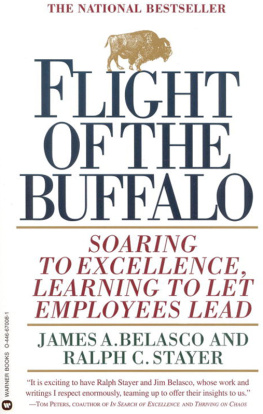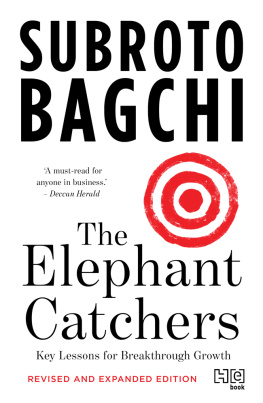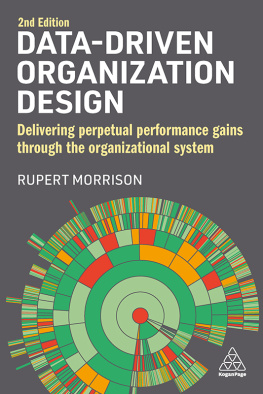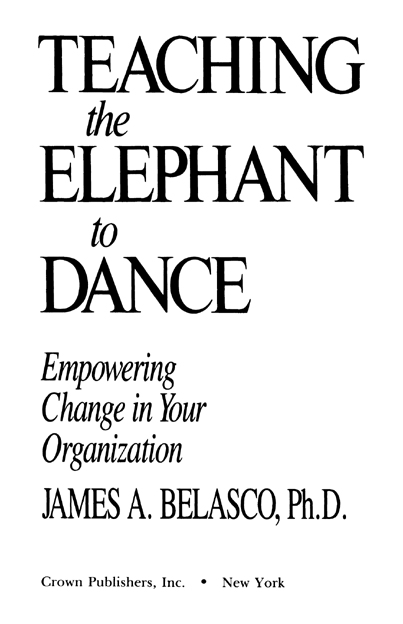Copyright 1990 by James A. Belasco, Ph.D.
All rights reserved. No part of this book may be reproduced or transmitted in any form or by any means, electronic or mechanical, including photocopying, recording, or by any information storage and retrieval system, without permission in writing from the publisher.
Published by Crown Publishers, Inc., 201 East 50th Street, New York, New York 10022. Member of the Crown Publishing Group.
Random House, Inc. New York, Toronto, London, Sydney, Auckland
Library of Congress Cataloging-in-Publication Data Belasco, James A.
Teaching the elephant to dance : empowering change in your organization / James A. Belasco.
p. cm.
1. Organizational change. I. Title.
HD58.8.B455 1990
658.4063dc20 89-25122
eISBN: 978-0-307-81874-4
v3.1
This book is dedicated to my teachersthe thousands of executives working to change their organizations. May your words and deedscaptured in the ink on these pageshelp others learn faster and enjoy the journey more.
Contents
Acknowledgments
No one writes a book alone. This particular effort has been the product of thousands of special peoples brains, eyes, hands, energy and time.
This is the fourth full version. Many individuals read, commented, and corrected previous editions. Each of their insights dramatically improved the manuscript. Their conviction that Elephant worked for them sustained me through the long hours at the computer.
Even more listened to presentations about the book. Their comments and reactions became part of the fodder for these pages. Yet more important, the fire of need burning in their eyes and their excitement about using Elephant to change their organizations encouraged me through the inevitable dark days of doubt and waiting.
I have been blessed with an extraordinary cast of teammates. Meredith Kunsa rightfully earns accolades from every one of our clients for her positive, helpful, competent manner. Her sharp administrative mind is without peer. Without her, Elephant would still be a sheaf of scattered papers. She is a gem.
Peggy Covert, who directs the Professional Development Program at San Diego State University, created numerous opportunities for me to test Elephant. Her entrepreneurial spirit is rare in university settings. SDSU, the San Diego business community, and I am fortunate she invests her considerable talent with us.
Chairs Penny Wright and Jim Beattyand my colleagues in the Management Department at SDSUwere very helpful in supporting me during the writing of Elephant. Thanks to them we have an excellent department. I am grateful that they continue to find ways in which I can contribute to our growing educational and research competence.
Editor Jim Wade has been stellar. Book publishing can prematurely age authors and editors alike. Jims belief in Elephantand his competence in piloting it through the publishing shoalsconverted potential traumas into gratifying experiences. Jim writes the best copy on short notice that Ive ever seen (hes the fastest man in the East with a typewriter). Jims excellent assistant Katie Towson handled the myriad details with aplomb.
I owe a debt to the thousands of practitioners from whose words and deeds Elephant draws life. Several of them are specifically cited in the textincluding Sam, Paul, and Ralph. Many others live between the lines, embodied in the printers ink on the page. This book is my effort to repay that obligation for the benefit of all those who follow.
This has been an incredible learning experience for me. As is typical, the credits for Elephant lie elsewhere. The faults rest with the author.
1
Teaching the Elephant to Dance Empowering Change in Your Organization
We need to change. Were in trouble. Business as usual is out.
Heres why.
Lower real wages. A weekly paycheck buys less today than it did twenty-five years ago.
U.S. and other Western countries market shares have declined in every major market since 1980.
Foreigners are buying national crown jewels for pennies. The papers are full of raiders crossing borders for asset grabs. Americans have seen such native jewels disappear into foreign ownership hands as Columbia Pictures, CBS Records, and Rockefeller Center (Rockettes and all). The British have seen Morgan Grenfell Group PLCthe sixth largest British merchant bankbought by Deutsche Bank, important pieces of the defense firm Plessey wind up in Siemens stable, and one of the last British luxury car medallionsJaguarbought by U.S. car maker Ford. And, the Belgians have seen their largest companySociete Generale de Belgique SAcome under combined French and Italian control.
In less than twenty years, if the trade deficit isnt improved, foreign companies will own enough dollars to buy every publicly traded company in the U.S. Today, one Japanese computer company has sufficient cash to buy all of Europes computer companiesand still have $7 billion left.
In market after market the U.S. as well as European countries are being outsold, outhustled, and outproduced.
I know Im not alone in feeling like Peter Finch, star of the movie Network, who urged his listeners to open up their windows and shout out, Im mad as hell, and Im not gonna take it anymore!
There are plenty of positive examples out there of people changing things around, bucking the trend. Big organizations. Small organizations. Government organizations. Manufacturing companies. Service organizations. There are examples we can learn from. This book is about how to do it in your organization.
ORGANIZATIONS ARE LIKE
ELEPHANTSSLOW TO CHANGE
Over the past decade Ive consulted with, studied, and managed a wide range of organizations. My experience tells me that organizations are like elephantsthey both learn through conditioning.
Trainers shackle young elephants with heavy chains to deeply embedded stakes. In that way the elephant learns to stay in its place. Older elephants never try to leave even though they have the strength to pull the stake and move beyond. Their conditioning limits their movements with only a small metal bracelet around their footattached to nothing.
Like powerful elephants, many companies are bound by earlier conditioned constraints. Weve always done it this way is as limiting to an organizations progress as the unattached chain around the elephants foot.
Success ties you to the past. The very factors that produced todays success often create tomorrows failure. Consider Xerox, for example. Xerox had a close call with disasterand it was mostly because of its own success. In the early and middle 1970s Xerox could do no wrongat least thats what they thought. They hired the best people, had the best marketing activities, and owned the market. Even to this day executives say, Make me a Xerox, when they want a copy. But all the right activities led the company to the brink of disaster.
Believing they were invincible, Xerox executives refused to take the Japanese competition seriously. They didnt realize, for instance, that the Japanese had a 50 percent cost advantage until five years after they lost significant market share. CEO David Kearns saw the need for change. He is busy now getting his elephants to leave their past constraints behind.








